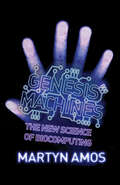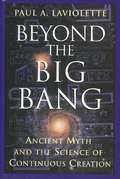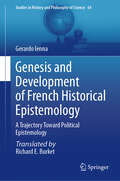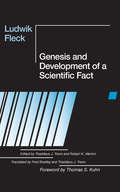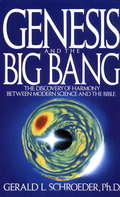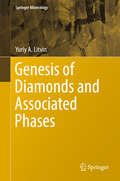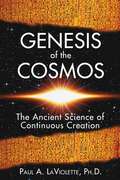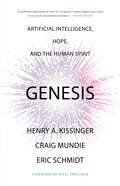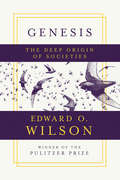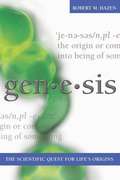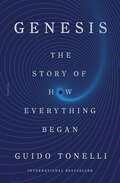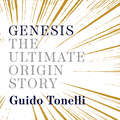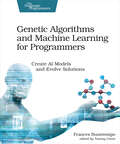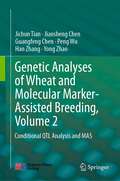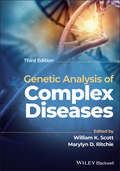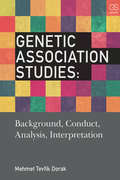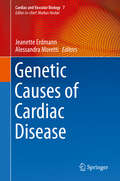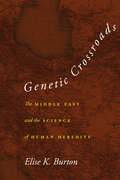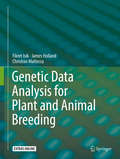- Table View
- List View
Genesis Machines: The New Science of Biocomputing
by Martyn AmosThe paperback version of the groundbreaking book about the next generation of computers: not only are they smaller—they're alive. Cells, gels, and DNA strands are the "wetware" of the twenty-first century. Imagine taking cells from a cancer patient and programming them to detect disease and then prompt the body to cure itself. Or clothes woven with microchips, nanofibers, and living cells to form wearable bio-weapons detection systems. Both of these revolutionary applications are closer than we think. Some scientists are pushing the boundaries even further by creating synthetic biology where brand new creatures are engineered in the laboratory. In this breathtaking book, a leading expert in the field reveals just how the stuff of science fiction is rapidly becoming a reality. This new technology will change the way we think—not just about computers, but about the nature of life itself.
Genesis Of The Cosmos: The Ancient Science of Continuous Creation
by Paul A. LavioletteThe author compares what we know scientifically with ancient myths across time
Genesis and Development of French Historical Epistemology: A Trajectory Toward Political Epistemology (Studies in History and Philosophy of Science #64)
by Gerardo IennaThis book forms an important part of the current revival of the debate around the category of historical epistemology. The term “historical epistemology” designates a methodology or research program aimed at building a historically informed theory of knowledge and/or a history of science and technology that enhances its epistemological aspects. This book offers an original panorama of the French debate surrounding the emergence and consolidation of the intellectual program of historical epistemology over a period ranging from the end of the 19th century to the second half of the 20th century. The first section of this book sets out to reconstruct sociologically and historically the processes of circulation of ideas - both nationally and internationally - that constituted the conditions of possibility for the emergence of the very idea of historical epistemology in the French intellectual context. The second section aims instead to highlight the main theoretical positions - both epistemological and historiographical - that would make it possible to trace a relative unity of intent among the authors who make up the canon of historical epistemology (in their oppositional relationship to other intellectual trends). Particular attention is also paid to defining a “minor canon” of this tradition, represented by what is known as “mathematical thought”. The third part of the volume focuses instead on reconstructing the anthropological, sociological and political perspectives underlying the methodology employed by authors belonging to historical epistemology. The three parts combined make for a uniquely broad yet focused book that is of interest to historians, philosophers and scientists alike.
Genesis and Development of a Scientific Fact
by Robert K. Merton Thaddeus J. Trenn Fred BradleyOriginally published in German in 1935, this monograph anticipated solutions to problems of scientific progress, the truth of scientific fact and the role of error in science now associated with the work of Thomas Kuhn and others. Arguing that every scientific concept and theory--including his own--is culturally conditioned, Fleck was appreciably ahead of his time. And as Kuhn observes in his foreword, "Though much has occurred since its publication, it remains a brilliant and largely unexploited resource." "To many scientists just as to many historians and philosophers of science facts are things that simply are the case: they are discovered through properly passive observation of natural reality. To such views Fleck replies that facts are invented, not discovered. Moreover, the appearance of scientific facts as discovered things is itself a social construction, a made thing. A work of transparent brilliance, one of the most significant contributions toward a thoroughly sociological account of scientific knowledge."--Steven Shapin, Science.
Genesis and Development of a Scientific Fact
by Ludwik Fleck; edited by Thaddeus J. Trenn and Robert K. Merton; translated by Fred Bradley and Thaddeus J. TrennOriginally published in German in 1935, this monograph anticipated solutions to problems of scientific progress, the truth of scientific fact and the role of error in science now associated with the work of Thomas Kuhn and others. Arguing that every scientific concept and theory—including his own—is culturally conditioned, Fleck was appreciably ahead of his time. And as Kuhn observes in his foreword, "Though much has occurred since its publication, it remains a brilliant and largely unexploited resource." "To many scientists just as to many historians and philosophers of science facts are things that simply are the case: they are discovered through properly passive observation of natural reality. To such views Fleck replies that facts are invented, not discovered. Moreover, the appearance of scientific facts as discovered things is itself a social construction, a made thing. A work of transparent brilliance, one of the most significant contributions toward a thoroughly sociological account of scientific knowledge."—Steven Shapin, Science
Genesis and the Big Bang Theory: The Discovery Of Harmony Between Modern Science And The Bible
by Gerald SchroederIn this groundbreaking book, physicist Gerald Schroeder takes on skeptics from both sides of the cosmological debate, arguing that science and the Bible are not at odds concerning the origin of the universe.From the Trade Paperback edition.
Genesis of Diamonds and Associated Phases (Springer Mineralogy)
by Yuriy A. LitvinThis book presents an overview of recent advances in our understanding of the genesis of diamonds and the associated phases. It is divided into three main parts, starting with an introduction to the analysis of diamond inclusions to infer the formation processes. In turn, the second part of the book presents high-pressure experimental studies in mantle diamond-parental mineral systems with representative multicomponent boundary compositions. The experimental syngenesis phase diagrams provided reveal the physicochemical mechanisms of diamond nucleation and substantiate the mantle-carbonatite concept of the genesis of diamonds and associated phases. Lastly, the book describes the genetic classification of diamond-hosted mineral inclusions and experimentally determined RE “mineral-parental melt” partition coefficients. The physicochemical experimental evidence presented shows the driving forces behind the fractional evolution of the mantle magmas and diamond-parental melts.Given the depth and breadth of its coverage, the book offers researchers essential new insights into the ways diamonds and associated minerals and rocks are naturally created.
Genesis of Symbolic Thought
by Alan BarnardSymbolic thought is what makes us human. Claude Lévi-Strauss stated that we can never know the genesis of symbolic thought, but in this powerful new study Alan Barnard argues that we can. Continuing the line of analysis initiated in Social Anthropology and Human Origins (Cambridge University Press, 2011), Genesis of Symbolic Thought applies ideas from social anthropology, old and new, to understand some of the areas also being explored in fields as diverse as archaeology, linguistics, genetics and neuroscience. Barnard aims to answer questions including: when and why did language come into being? What was the earliest religion? And what form did social organization take before humanity dispersed from the African continent? Rejecting the notion of hunter-gatherers as 'primitive', Barnard hails the great sophistication of the complex means of their linguistic and symbolic expression and places the possible origin of symbolic thought at as early as 130,000 years ago.
Genesis of the Cosmos: The Ancient Science of Continuous Creation
by Paul A. LavioletteProvides compelling evidence that creation myths from the dawn of civilization correspond to cutting edge astronomical discoveries • Exposes the contradictions in current cosmological theory and offers a scientific basis for the ancient myths and esoteric lore that encode a theory of continuous creation• By the scientist who was the first to disprove the Big Bang theory on the basis of observational dataRecent developments in theoretical physics, including systems theory and chaos theory, are challenging long-held mechanistic views of the universe. Many thinkers have speculated that the remnants of an ancient science survive today in mythology and esoteric lore, but until now the scientific basis for this belief has remained cloaked in mystery. Paul LaViolette reveals the remarkable parallels between the cutting edge of scientific thought and creation myths from the dawn of civilization. With a scientific sophistication rare among mythologists, LaViolette deciphers the forgotten cosmology of ancient lore in a groundbreaking scientific tour de force. In direct, nontechnical language, he shows how these myths encode a theory of cosmology in which matter is continually growing from seeds of order that emerge spontaneously from the surrounding subquantum chaos.Exposing the contradictions that bedevil the big bang theory, LaViolette offers both the specialist and the general reader a controversial and highly stimulating critique of prevailing misconceptions about the seldom-questioned superiority of modern science over ancient cosmology. By restoring and reanimating this ancient scientific worldview, Genesis of the Cosmos leads us beyond the restrictive metaphors of modern science and into a new science for the 21st century.
Genesis of the Salk Institute
by Suzanne BourgeoisThis work is a personal account of the origins and early years of the Salk Institute for Biological Studies. Bourgeois crafts an engaging study that draws on her involvement with the Institute and on related archives, interviews, and informal conversations.The volume discusses the people who founded the Institute and built a home for renowned research--leading scientists of the time as well as non-scientists of stature in finance, politics, philanthropy, publishing, and the humanities. The events that brought people together, the historic backdrop in which they worked, their personalities, their courage and their visions, their clash of egos and their personal vanities are woven together in a rich, engaging narrative about the founding of a world-premier research institution.
Genesis: Artificial Intelligence, Hope, and the Human Spirit
by Henry A. Kissinger Eric Schmidt Craig MundieIn his final book, the late Henry Kissinger joins forces with two leading technologists to mount &“a profound exploration&” (Walter Isaacson) of the epochal challenges and opportunities presented by the revolution in Artificial Intelligence: a breakthrough that dramatically empowers people in all walks of life while also raising urgent questions about the future of humanity. As it absorbs data, gains agency, and intermediates between humans and reality, AI (Artificial Intelligence) will help us to address enormous crises, from climate change to geopolitical conflicts to income inequality. It might well solve some of the greatest mysteries of our universe and elevate the human spirit to unimaginable heights. But it will also pose challenges on a scale and of an intensity that we have never seen—usurping our power of independent judgment and action, testing our relationship with the divine, and perhaps even spurring a new phase in human evolution. The last book of elder statesman Henry Kissinger, written with technologists Craig Mundie and Eric Schmidt, Genesis charts a course between blind faith and unjustified fear as it outlines an effective strategy for navigating the age of AI.
Genesis: The Deep Origin Of Societies
by Edward O. WilsonForming a twenty-first-century statement on Darwinian evolution, one shorn of “religious and political dogma,” Edward O. Wilson offers a bold work of scientific thought and synthesis. Asserting that religious creeds and philosophical questions can be reduced to purely genetic and evolutionary components, and that the human body and mind have a physical base obedient to the laws of physics and chemistry, Genesis demonstrates that the only way for us to fully understand human behavior is to study the evolutionary histories of nonhuman species. Of these, Wilson demonstrates that at least seventeen—among them the African naked mole rat and the sponge- dwelling shrimp—have been found to have advanced societies based on altruism and cooperation. Whether writing about midges who “dance about like acrobats” or schools of anchovies who protectively huddle “to appear like a gigantic fish,” or proposing that human society owes a debt of gratitude to “postmenopausal grandmothers” and “childless homosexuals,” Genesis is a pithy yet path-breaking work of evolutionary theory, braiding twenty-first-century scientific theory with the lyrical biological and humanistic observations for which Wilson is known.
Genesis: The Scientific Quest for Life's Origin
by Robert M. HazenLife on Earth arose nearly 4 billion years ago, bursting forth from air, water, and rock. Though the process obeyed all the rules of chemistry and physics, the details of that original event pose as deep a mystery as any facing science. How did non-living chemicals become alive? While the question is (deceivingly) simple, the answers are unquestionably complex. Science inevitably plays a key role in any discussion of life's origins, dealing less with the question of why life appeared on Earth than with where, when, and how it emerged on the blasted, barren face of our primitive planet. Astrobiologist Robert Hazen has spent many years dealing with the fundamental questions of life's genesis. As an active research scientist, he is down deep in all the messy details that science has to offer on the subject, tracing the inexorable sequence of events that led to the complicated interactions of carbonbased molecules. As he takes us through the astounding process of emergence, we are witness to the first tentative steps toward life--from the unfathomable abundance of carbon biomolecules synthesized in the black vacuum of space to the surface of the Earth to deep within our planet's restless crust. We are privy to the breathtaking drama that rapidly unfolds as life prevails. The theory of emergence is poised to answer a multitude of questions--even as it raises the possibility that natural processes exist beyond what we now know, perhaps beyond what we even comprehend. Genesis tells the tale of transforming scientific advances in our quest for life's origins. Written with grace, beauty, and authority, it goes directly to the heart of who we are and why we are here.
Genesis: The Story of How Everything Began
by Guido TonelliA breakout bestseller in Italy, now available for American readers for the first time, Genesis: The Story of How Everything Began is a short, humanistic tour of the origins of the universe, earth, and life—drawing on the latest discoveries in physics to explain the seven most significant moments in the creation of the cosmos.Curiosity and wonderment about the origins of the universe are at the heart of our experience of the world. From Hesiod’s Chaos, described in his poem about the origins of the Greek gods, Theogony, to today’s mind-bending theories of the multiverse, humans have been consumed by the relentless pursuit of an answer to one awe inspiring question: What exactly happened during those first moments?Guido Tonelli, the acclaimed, award-winning particle physicist and a central figure in the discovery of the Higgs boson (the “God particle”), reveals the extraordinary story of our genesis—from the origins of the universe, to the emergence of life on Earth, to the birth of human language with its power to describe the world. Evoking the seven days of biblical creation, Tonelli takes us on a brisk, lively tour through the evolution of our cosmos and considers the incredible challenges scientists face in exploring its mysteries. Genesis both explains the fundamental physics of our universe and marvels at the profound wonder of our existence.
Genesis: The Ultimate Origin Story
by Guido TonelliWhat if the ancient Greeks were right, and the universe really did spring into being out of chaos and the void? How could we know? And what must its first moments have been like?To answer these questions, scientists are delving into all the hidden crevices of creation. Armed with giant telescopes and powerful particle accelerators, they probe the subtle mechanisms by which our familiar world came to be, and try to foretell the manner in which it will end.The result of all this collective effort is a complex story, stranger at times than even our most ancient creation myths. But its building blocks give us the power to work marvels our predecessors could scarcely comprehend. In Genesis, the CERN physicist and bestselling author Guido Tonelli sets out to do justice to that great story.
Genetic Algorithms and Machine Learning for Programmers
by Frances BuontempoSelf-driving cars, natural language recognition, and online recommendation engines are all possible thanks to Machine Learning. Now you can create your own genetic algorithms, nature-inspired swarms, Monte Carlo simulations, cellular automata, and clusters. Learn how to test your ML code and dive into even more advanced topics. If you are a beginner-to-intermediate programmer keen to understand machine learning, this book is for you. Discover machine learning algorithms using a handful of self-contained recipes. Build a repertoire of algorithms, discovering terms and approaches that apply generally. Bake intelligence into your algorithms, guiding them to discover good solutions to problems. In this book, you will: Use heuristics and design fitness functions.Build genetic algorithms.Make nature-inspired swarms with ants, bees and particles.Create Monte Carlo simulations.Investigate cellular automata.Find minima and maxima, using hill climbing and simulated annealing.Try selection methods, including tournament and roulette wheels.Learn about heuristics, fitness functions, metrics, and clusters. Test your code and get inspired to try new problems. Work through scenarios to code your way out of a paper bag; an important skill for any competent programmer. See how the algorithms explore and learn by creating visualizations of each problem. Get inspired to design your own machine learning projects and become familiar with the jargon. What You Need: Code in C++ (>= C++11), Python (2.x or 3.x) and JavaScript (using the HTML5 canvas). Also uses matplotlib and some open source libraries, including SFML, Catch and Cosmic-Ray. These plotting and testing libraries are not required but their use will give you a fuller experience. Armed with just a text editor and compiler/interpreter for your language of choice you can still code along from the general algorithm descriptions.
Genetic Analyses of Wheat and Molecular Marker-Assisted Breeding, Volume 1
by Chun Li Jichun Tian Zhiying Deng Kunpu Zhang Haixia Yu Xiaoling JiangThe book mainly describes the QTL mappings and efficacy analyses that are associated with wheat productivity, quality, physiology and various stress resistances and provides summaries of results from studies conducted both at home and abroad. It presents comparable data and analyses, helping readers to arrive at a more comprehensive understanding of the latest development in this field. The book provides a wealth of novel information, broad range of applications and in-depth findings on crop genetics and molecular breeding, making it valuable not only for plant breeders but also for academic faculties, senior researchers and advanced graduate students who are involved in plant breeding and genetics. Dr. Jichun Tian is a professor at the Department of Agronomy, Shandong Agricultural University, Tai'an, China.
Genetic Analyses of Wheat and Molecular Marker-Assisted Breeding, Volume 2
by Yong Zhao Peng Wu Jichun Tian Jiansheng Chen Guangfeng Chen Han ZhangWhile focusing on various interactions between trait genes/QTL and dynamic expressions of conditional QTL genes, this book also discusses aspects of molecular marker-assisted breeding, and applications of molecular markers associated with yield, quality, physiology and disease resistance in wheat. It covers QTL studies in wheat breeding and presents the available information on wheat MAS breeding. This volume provides a wealth of novel information, a wide range of applications and deep insights into crop genetics and molecular breeding, which is valuable not only for plant breeders but also for academic faculties, senior researchers and advanced graduate students who are involved in plant breeding and genetics. Dr. Jichun Tian is a professor at the Department of Agronomy, Shandong Agricultural University, Tai'an, China.
Genetic Analyses of Wheat and Molecular Marker-Assisted Breeding, Volume 2: Conditional QTL Analysis and MAS
by Yong Zhao Peng Wu Jichun Tian Jiansheng Chen Guangfeng Chen Han ZhangWhile focusing on various interactions between trait genes/QTL and dynamic expressions of conditional QTL genes, this book also discusses aspects of molecular marker-assisted breeding, and applications of molecular markers associated with yield, quality, physiology and disease resistance in wheat. It covers QTL studies in wheat breeding and presents the available information on wheat MAS breeding. This volume provides a wealth of novel information, a wide range of applications and deep insights into crop genetics and molecular breeding, which is valuable not only for plant breeders but also for academic faculties, senior researchers and advanced graduate students who are involved in plant breeding and genetics. Dr. Jichun Tian is a professor at the Department of Agronomy, Shandong Agricultural University, Tai’an, China.
Genetic Analysis of Complex Disease
by William K. Scott Marylyn D. RitchieGenetic Analysis of Complex Diseases An up-to-date and complete treatment of the strategies, designs and analysis methods for studying complex genetic disease in human beings In the newly revised Third Edition of Genetic Analysis of Complex Diseases, a team of distinguished geneticists delivers a comprehensive introduction to the most relevant strategies, designs and methods of analysis for the study of complex genetic disease in humans. The book focuses on concepts and designs, thereby offering readers a broad understanding of common problems and solutions in the field based on successful applications in the design and execution of genetic studies. This edited volume contains contributions from some of the leading voices in the area and presents new chapters on high-throughput genomic sequencing, copy-number variant analysis and epigenetic studies. Providing clear and easily referenced overviews of the considerations involved in genetic analysis of complex human genetic disease, including sampling, design, data collection, linkage and association studies and social, legal and ethical issues. Genetic Analysis of Complex Diseases also provides: A thorough introduction to study design for the identification of genes in complex traits Comprehensive explorations of basic concepts in genetics, disease phenotype definition and the determination of the genetic components of disease Practical discussions of modern bioinformatics tools for analysis of genetic data Reflecting on responsible conduct of research in genetic studies, as well as linkage analysis and data management New expanded chapter on complex genetic interactions This latest edition of Genetic Analysis of Complex Diseases is a must-read resource for molecular biologists, human geneticists, genetic epidemiologists and pharmaceutical researchers. It is also invaluable for graduate students taking courses in statistical genetics or genetic epidemiology.
Genetic Association Studies: Background, Conduct, Analysis, Interpretation
by Mehmet Tevfik DorakGenetic Association Studies is designed for students of public health, epidemiology, and the health sciecnes, covering the main principles of molecular genetics, population genetics, medical genetics, epidemiology and statistics. It presents a balanced view of genetic associations with coverage of candidate gene studies as well as genome-wide association studies. All aspects of a genetic association study are included, from the lab to analysis and interpretation of results, but also bioinformatics approaches to causality assessment. The role of the environment in genetic disease is also highlighted. Genetic Association Studies will enable readers to understand and critique genetic association studies and set them on the way to designing, executing, analyzing, interpreting, and reporting their own.
Genetic Causes of Cardiac Disease (Cardiac and Vascular Biology #7)
by Jeanette Erdmann Alessandra MorettiThis book provides a comprehensive summary of the latest developments in the field of the genomics of cardiac disease. Written and edited by leading clinicians and scientists involved in the analysis and therapy of genetic cardiac disorders, it discusses the genetic causes of a variety of cardiac diseases, such as the complex genetics and etiology of congenital heart diseases. It also explores sex differences in prevalent diseases, genetics-based therapeutic strategies and the use of various animal models and alternatives. The book is intended for research scientists and clinical scientists in the cardiovascular field, human geneticists and cardiologists.
Genetic Counseling Practice
by Bonnie S. Leroy Patricia M. Veach Dianne M. BartelsThe first advanced-level genetics counseling skills resourceAs genetic medicine and testing continue to expand, so the role of the genetic counselor is transforming and evolving. Genetic Counseling Practice: Advanced Concepts and Skills is the first text to address ways that genetic counselors can deepen their skills to meet expanding practice demands. This timely resource not only helps readers further develop their abilities to gather relevant data and interpret it for patients, it also aids them in surpassing their usual role by truly understanding patient situations, incorporating patient values into clinical practice, providing in-depth support, and facilitating thoroughly informed, autonomous decisions.Edited by an expert cross-disciplinary team consisting of a genetic counseling program director, a licensed psychologist, and a nurse/bioethicist/family social scientist, this authoritative reference provides specific and detailed instruction in addressing psychosocial aspects of genetic counseling practice and professional development and training issues of genetic counselors.Provides a process view of genetic counselor service provision; i.e., skills that promote desired genetic counseling outcomes are emphasized (such as relationship skills, patient characteristics, client behaviors, and extra-clinical skills)Includes experiential activities in every chapter to help readers apply concepts and skillsDraws on the experience of widely recognized experts in genetic counseling theory, practice, and research, who serve as chapter authorsFeatures numerous specific, real-life examples from clinical practiceGenetic Counseling Practice addresses issues relevant to practicing genetic counselors as well as students of genetic counseling programs. In addition, oncology nurses, social workers, and psychologists working with genetic counseling patients and families; medical geneticists and physicians training in the field; and physician assistants will also benefit from this resource.
Genetic Crossroads: The Middle East and the Science of Human Heredity
by Elise K. BurtonThe Middle East plays a major role in the history of genetic science. Early in the twentieth century, technological breakthroughs in human genetics coincided with the birth of modern Middle Eastern nation-states, who proclaimed that the region's ancient history—as a cradle of civilizations and crossroads of humankind—was preserved in the bones and blood of their citizens. Using letters and publications from the 1920s to the present, Elise K. Burton follows the field expeditions and hospital surveys that scrutinized the bodies of tribal nomads and religious minorities. These studies, geneticists claim, not only detect the living descendants of biblical civilizations but also reveal the deeper past of human evolution. Genetic Crossroads is an unprecedented history of human genetics in the Middle East, from its roots in colonial anthropology and medicine to recent genome sequencing projects. It illuminates how scientists from Turkey to Yemen, Egypt to Iran, transformed genetic data into territorial claims and national origin myths. Burton shows why such nationalist appropriations of genetics are not local or temporary aberrations, but rather the enduring foundations of international scientific interest in Middle Eastern populations to this day.
Genetic Data Analysis for Plant and Animal Breeding
by James Holland Fikret Isik Christian MalteccaThis book fills the gap between textbooks of quantitative genetic theory, and software manuals that provide details on analytical methods but little context or perspective on which methods may be most appropriate for a particular application. Accordingly this book is composed of two sections. The first section (Chapters 1 to 8) covers topics of classical phenotypic data analysis for prediction of breeding values in animal and plant breeding programs. In the second section (Chapters 9 to 13) we provide the concept and overall review of available tools for using DNA markers for predictions of genetic merits in breeding populations. With advances in DNA sequencing technologies, genomic data, especially single nucleotide polymorphism (SNP) markers, have become available for animal and plant breeding programs in recent years. Analysis of DNA markers for prediction of genetic merit is a relatively new and active research area. The algorithms and software to implement these algorithms are changing rapidly. This section represents state-of-the-art knowledge on the tools and technologies available for genetic analysis of plants and animals. However, readers should be aware that the methods or statistical packages covered here may not be available or they might be out of date in a few years. Ultimately the book is intended for professional breeders interested in utilizing these tools and approaches in their breeding programs. Lastly, we anticipate the usage of this volume for advanced level graduate courses in agricultural and breeding courses.
